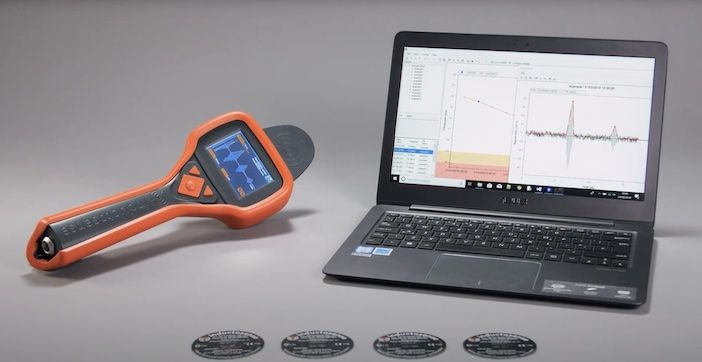Alexander Ballisat, senior research engineer at the Centre for Modelling and Simulation (CFMS)
The aerospace industry’s exemplary safety record is built on some of the highest safety standards and most rigorous inspection regimes around. Non-destructive testing has played a significant role in this success story – now the increased digitalisation of non-destructive testing is helping the industry save money and improve sustainability.
Non-destructive testing (NDT) is typically used throughout a product’s lifecycle: from the design process of a new aircraft, to in-service inspections of components and structures and on to extending the life of aging aircraft. There are a variety of surface and sub-surface NDT techniques which can be used, but all serve the purpose of identifying defects in components to ensure the airworthiness and safety of an aircraft.
Dawn of digitalisation
In recent years, there has been an increased used of digitisation in inspections. Radiography is a good example. It involves using x-rays to examine the internal structure of manufactured components to identify any flaws or defects. Traditionally, photographic film was used to capture the results but this is being replaced by digital detectors. Digitalisation has meant that, rather than taking and storing hundreds of pictures of a particular component, engineers can create a digital record that can be easily stored, searched and analysed in many different ways by a computer system.
Digital history
This has been a game changer for NDT. Over time, all those records create a ‘digital history’ for a part during its lifecycle. This powerful information can be used in many different ways, beyond just assessing structural integrity. The wealth of data enables you to make informed choices about whether or not a component needs to be replaced. In practice, this means that rather than taking a manufacturer’s estimates of the number of flight hours a component would typically offer, regular NDT inspections can more accurately determine the time at which that product needs to be replaced under the circumstances in which it’s being used.
For an industry in which maintenance can be both time consuming and expensive, this is a big deal. If you can make intelligent decisions about how much useful life a component has left, you can avoid unnecessarily replacing it, which, in turn, reduces wastage and downtime – and saves on materials and money.
Closing the loop
This is great news for the industry – but used in the right way, the digitalisation of NDT data can also bring further efficiencies by shaping the design of the next generation of aircraft. The amount of in-service NDT data which manufacturers log about the performance and degradation of aircraft components can and should be fed back into the design process to close the loop and continually drive improvements.
At a simple level, NDT data tells you if you need to improve the design of a part to meet requirements or if that part is already performing to required standards. If the latter is true, then there’s no need to waste time or money on making design changes. In practice, this only tends to happen reactively when a part has failed. But there is a real opportunity for the industry to proactively incorporate NDT data into the design process where many small changes will have a big impact.
For example, based on experience, you may expect a component to have a particular degradation rate. If the NDT data shows that the component actually performs better than expected and the degradation rate is significantly slower than predicted, then you know that the component is overdesigned. Going back to the design process, that component could be redesigned to make it lighter. Through modelling and simulation techniques which use the NDT data, you would still know that it could perform to the required standard – but you will have saved weight, therefore, reducing fuel consumption, costs and environmental impact.
NDT already plays an important role in upholding the aerospace industry’s high standards for safety but in combining digitalisation with developments in modelling and simulation, organisations have an opportunity to save money and improve sustainability through intelligent design.
Case study: Next generation digital NDT
The Centre for Modelling and Simulation (CFMS) recently worked with ultrasonic sensor technology company Inductosense. The company, which works in a variety of industries including aerospace, has developed a non-intrusive, semi-automated corrosion monitoring solution based on NDT for testing corrosion and erosion that is cost-effective, simplified and digitized.
Known as the WAND system, Inductosense’s solution uses a combination of battery-free, ultrasonic thickness sensors that are permanently installed to the surface of components, often in hard-to-reach areas. The WAND is a handheld data collection tool that provides power wirelessly to the sensors, and then measures the thickness of the material to which it is attached.

Inductosense wanted to rigorously test and validate the performance of the WAND system so turned to CFMS to use its modelling and simulation expertise.
By building a virtual model of both the WAND sensor, and a pipe under test, CFMS’s simulation experts were able to create a digital twin of the system. With this virtual system, different parameters could be varied, then finite element analysis on each configuration could generate a simulated performance. Digitally varying all parameters using the CFMS’s high performance computing generated more than 400,000 data points, which were then processed by the CFMS team. By using these digital engineering techniques to generate data, Inductosense did not have to experiment with physical test pipes, which would have been very difficult and extremely expensive.
“The WAND system offers a lot of advantages over traditional NDT systems, but we needed to verify the novel engineering approach provided accurate measurements,” said Dr Matt Butcher, CEO of Inductosense. “Our experimental validation was complemented by CFMS’ simulation, which provided us with added confidence that the WAND performance met end user needs.”
Alexander Ballisat is a senior research engineer and part of the model-based engineering team at the Centre for Modelling & Simulation (CFMS), a not-for-profit specialist in digital engineering capability.





